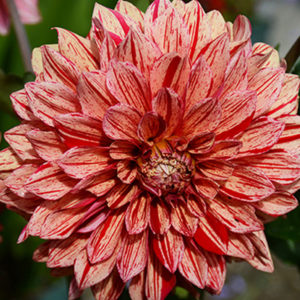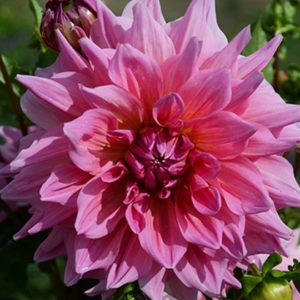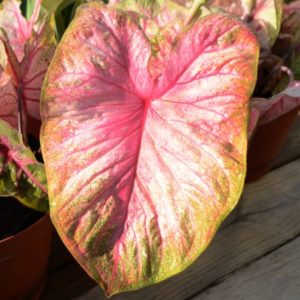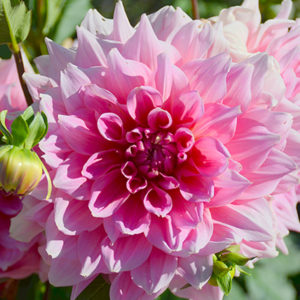Description
 Allium,
Allium,
Aflatunense
The Allium family includes an enormous collection of plants including leeks, onions, elephant garlic and shallots. There are more than 200 species and thousands of cultivars. In the wild, they are found all over the Northern Hemisphere including North America, the Middle East, western China, the Pyrenees, the Alps and the Mediterranean. They flourish with exposure to full sun, in rugged mountainous areas where the ground drains quickly and completely. They also love bonemeal, so add a generous helping of bonemeal (1/4 cup) to the hole where you plant each bulb.
Of all the ‘critter resistant’ bulbs, the Alliums are the most ‘critter resistant’. Deer, rabbits, squirrels, mice, moles and voles cannot stand the smell of Alliums. The fragrance is so strong and so offensive to critters that Alliums can be used to deter the critters from tulips and other more vulnerable bulbs. A critter has to be really desperate to eat an Allium.
Allium siculum ssp. Bulgaricum is also known scientifically as Nectaroscodum siculum ssp.bulgaricum. Its common name is The Sicilian Honey Lily. It is a very rare and very unusual Allium which would never be recognized as an Allium. This Allium is native to southern France and Sicily. The plant was introduced in the 1700s, but did not become popularly available until 1873.
The 32-36 inch plants produce 2 inch wide umbrels (tassel-like flowerheads) of pendant greenish-white, bell-shaped florets flushed with purple and edged in white. Each floret dangles from a wiry 4 inch stem. The plants have low strappy foliage that dies back early. It blooms late season and shows best when planted in groups of 10-25 bulbs.
The plants can be grown in full to partial shade, but require a dry period during the summer in order to flourish. Plant Allium Siculum bulgaricum bulbs at least 6-8 inches deep and 4 inches apart and don’t forget to add a quarter cup of bonemeal to each bulb hole. They need full sun and do best when grown in loamy soil.
Planting Bulbs in the Fall for Glorious Spring Color
Bulbs are some of the easiest plants to grow. Fundamentally the process requires four steps.
1. Dig a hole.
2. Dust the hole with bonemeal.
3. Place the bulb in the hole.
4. Fill the hole with soil.
There are, however, some additional refinements which help produce even more lavish results and enhance protection from critters.
First, bulbs can and should be planted deeper than the instructions you receive on the package labels. An easy way to remember how deep to plant the bulb is to think of a quarter. If the bulb you are planting has the same diameter as a quarter or less, plant the bulb 4 inches deep. If the bulb is broader than a quarter, plant it 6-10 inches deep. Large bulbs like some alliums, camassias, standard tulips and fritillaries can easily be planted 10 inches deep. As the soil compacts days, weeks and months after planting, it produces a thinner layer of soil on top of the bulb. Planting bulbs deep helps with critter control. Moles, voles, chipmunks and squirrels are lazy little creatures, and they don’t like doing a lot of digging to reach their food.
Second, bonemeal is a must. It is an excellent source of calcium and phosphorus which help the bulbs to form a strong root system and healthy stems. For large bulbs (those bigger than a quarter), use ¼ cup per bulb. For small bulbs, dust the entire surface or hole where the bulbs will reside.
Third, small bulbs should be planted in clusters of 10 or more – 1 inch apart. Large bulbs, like allium, can stand along, but create a much more pleasing presence in the garden when planted is clusters of 3-5. They should be separated by no more than 4-6 inches.
Fourth, bulbs usually multiply fairly quickly and once crowded will not produce blossoms. Plan to divide your bulbs in mid-summer to fall when the top growth has dried out.
These simple, easy, quick tasks are all that is required to produce a lovely bulb display year after year.
Planting Bulbs in Containers
If you live in Hardiness Zones 5 and higher all you need to do is mix some soil. . Check out the soil mix described in detail in our Harvesting History YouTube video. Do not use prepared soil mixes.
The Best Soil Mix for Containers
Always plant bulbs more densely in containers than in the ground. Pots as small as 6-inches in diameter can have a showy presence on a deck, porch or patio. You can use much larger pots and plant several kinds of bulbs.
Fill the pot half full, dust the soil surface with bonemeal, arrange the bulbs on top of the bone meal and fill the pot with the rest of the soil. Dust the surface of the soil with more bonemeal. Water thoroughly, but do not let the pot stand in a saucer of water.
If you live in Hardiness Zones 1-4, you must protect the pots by bringing them into an unheated garage or surrounding them with bales of straw. If you do not do this, the bulbs usually freeze and turn to mush.
Introduction to Fall Bulbs
Introduction HH Allium Collection
Allium Amplectens, Graceful Beauty
Allium Nigrum – Bulbs for Fall Planting
Allium Caesium AKA Allium Urecolatum – Bulbs for Fall Planting





